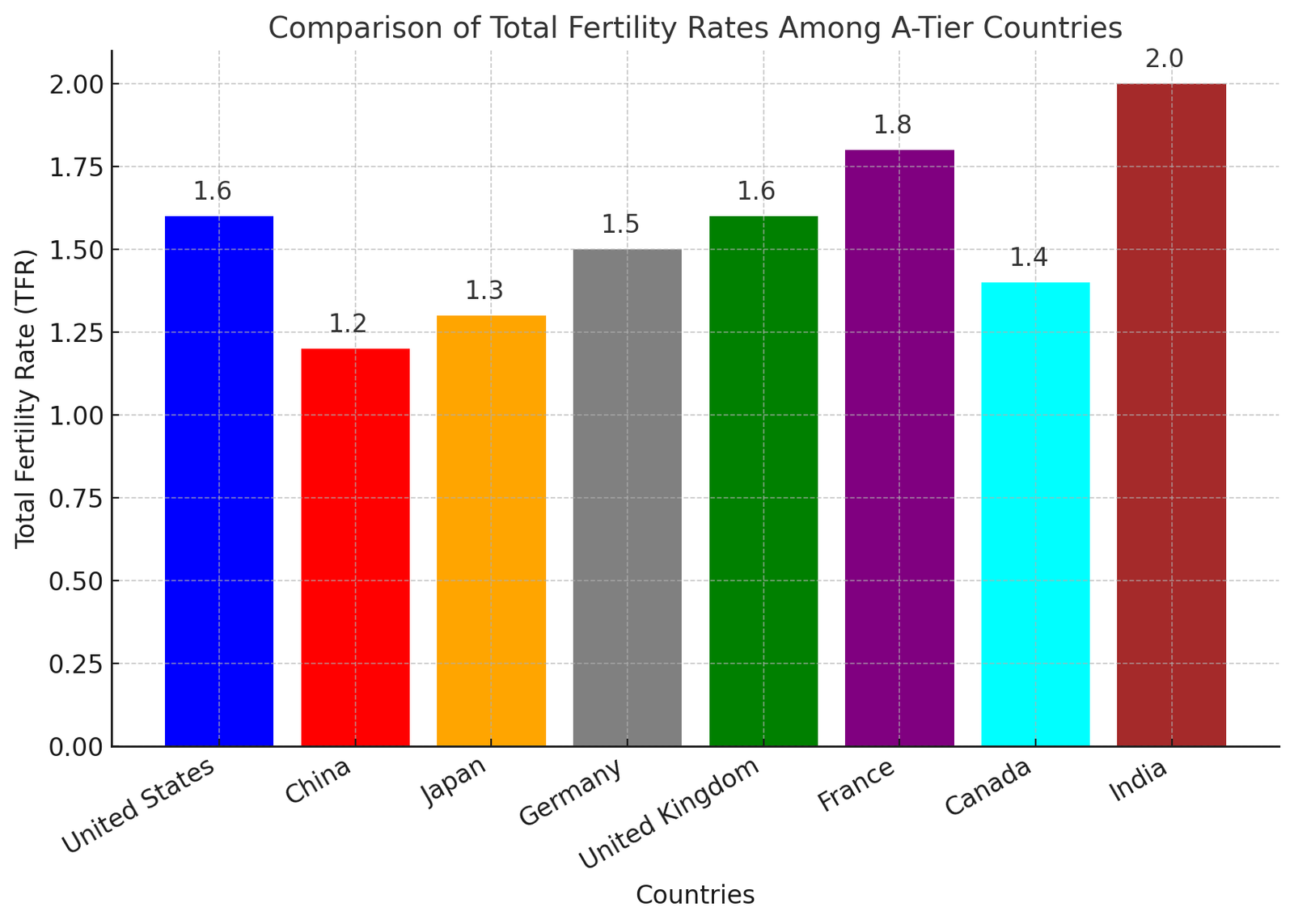
For decades, the United States has relied on a steady birth rate to sustain its population and economic growth. However, the latest data from the National Center for Health Statistics (NCHS) paints a different picture—one of steady decline in birth rates across various demographics. This shift is not just a statistical anomaly; it reflects deeper societal and economic trends that could shape America's future in significant ways.
A Record-Low Fertility Rate
The total fertility rate (TFR) in the U.S. has dropped to 1.6 births per woman, a historic low and well below the replacement rate of 2.1 needed to maintain a stable population without immigration. According to the Centers for Disease Control and Prevention (CDC), this decline has been ongoing since the Great Recession of 2008, with an average annual decrease of about 2%. If the trend continues, the U.S. may experience a shrinking workforce, increased dependency ratios, and economic stagnation.
Comparatively, nations like Japan (TFR: 1.3), South Korea (TFR: 0.72), and Italy (TFR: 1.2) face similar population crises, leading to labor shortages, increased retirement burdens, and slowed economic expansion. Meanwhile, countries with higher fertility rates, such as India (TFR: 2.0) and Nigeria (TFR: 5.1), continue to experience rapid population growth, presenting contrasting demographic challenges.
Delayed Motherhood and Changing Priorities
One of the most striking aspects of the report is the shift in the average age of first-time mothers. The data reveals that the average age for a woman giving birth for the first time has reached 27.5 years, an all-time high. This trend is largely driven by women prioritizing education and career advancement over early parenthood.
A 2023 study by the Pew Research Center found that 44% of adults aged 18-49 cite financial instability as the primary reason for delaying parenthood, with the rising costs of childcare, education, and housing acting as deterrents. According to the Brookings Institution, raising a child in the U.S. now costs approximately $310,000 from birth to age 17, further discouraging young families.
Sociologist Dr. Emily Hayford explains: "When people are uncertain about the future, they tend to postpone major life decisions, including having children. Economic concerns, career goals, and the rising cost of childcare all contribute to this shift."
Teen Birth Rates Plummet
Another major finding is the 68% decline in teen birth rates since 2007, with a further 4% drop in 2023 compared to the previous year. This significant decrease can be attributed to better access to contraception, improved sex education, and shifting societal norms that discourage early pregnancy. While this trend is seen as a positive development for teenage well-being and education, it also contributes to the overall decline in birth rates.
Economic and Social Consequences
The declining birth rate has broad implications for the future of the U.S. economy. A shrinking younger population means fewer workers to support retirees, potentially putting pressure on Social Security and healthcare systems. The Congressional Budget Office (CBO) projects that by 2035, the number of retirees will outnumber children under 18 for the first time in U.S. history, straining government programs that rely on a stable workforce to fund them.
A labor shortage is already becoming evident in industries such as healthcare, education, and manufacturing. The U.S. Chamber of Commerce estimates that by 2030, the labor force participation rate will drop to 59%, further slowing economic growth. Additionally, a lower birth rate could reshape urban planning, education funding, and housing markets. Fewer children may lead to school closures in some areas, while the demand for childcare services and family-friendly housing could shift accordingly.
Immigration No Longer a Viable Solution?
In the past, immigration was seen as a solution to offset declining birth rates. However, recent policy shifts have made this less certain. The Trump administration has intensified deportation efforts, implementing mass removals and stricter border policies. With an increasing number of immigrants being returned to their native countries, the U.S. may struggle to fill labor gaps left by declining birth rates.
Experts warn that reduced immigration, combined with falling birth rates, could lead to labor shortages, slower economic growth, and increased pressure on Social Security. While some advocate for pro-family policies like paid parental leave and childcare subsidies to boost native birth rates, others argue that restrictive immigration policies will need to be reconsidered if the U.S. is to maintain a stable workforce and economic momentum.
Government Incentives and Potential Policy Responses
Countries facing similar demographic challenges have introduced policy interventions to boost birth rates. In France, financial incentives such as paid parental leave and free childcare have helped maintain a fertility rate close to replacement level (TFR: 1.8). Sweden’s extensive family benefits, including generous paternity leave, have led to a relatively stable birth rate.
In contrast, the U.S. lacks a universal paid parental leave policy, and the cost of childcare remains among the highest in the world. A 2022 report by the Economic Policy Institute found that the average annual cost of infant care in the U.S. is $15,000—nearly 22% of the median household income.
Policymakers in the U.S. have started discussing potential solutions, including:
- Expanding tax credits for families with children
- Increasing subsidized childcare options
- Implementing federal paid parental leave programs
However, political gridlock has slowed efforts to enact comprehensive pro-natalist policies.
A Societal Transformation
The U.S. is undergoing a demographic transformation with long-term consequences that will affect every aspect of society. While declining birth rates may alleviate some pressures, such as overcrowded schools and environmental concerns, they also pose significant economic and social challenges.
As policymakers and society at large grapple with these shifts, the choices made today will determine the country’s future stability and prosperity. Would government incentives, such as childcare subsidies, paid parental leave, or tax benefits for families, help reverse this trend? Only time will tell. However, one thing is clear: America’s demographic landscape is changing, and the effects will be felt for generations to come.

